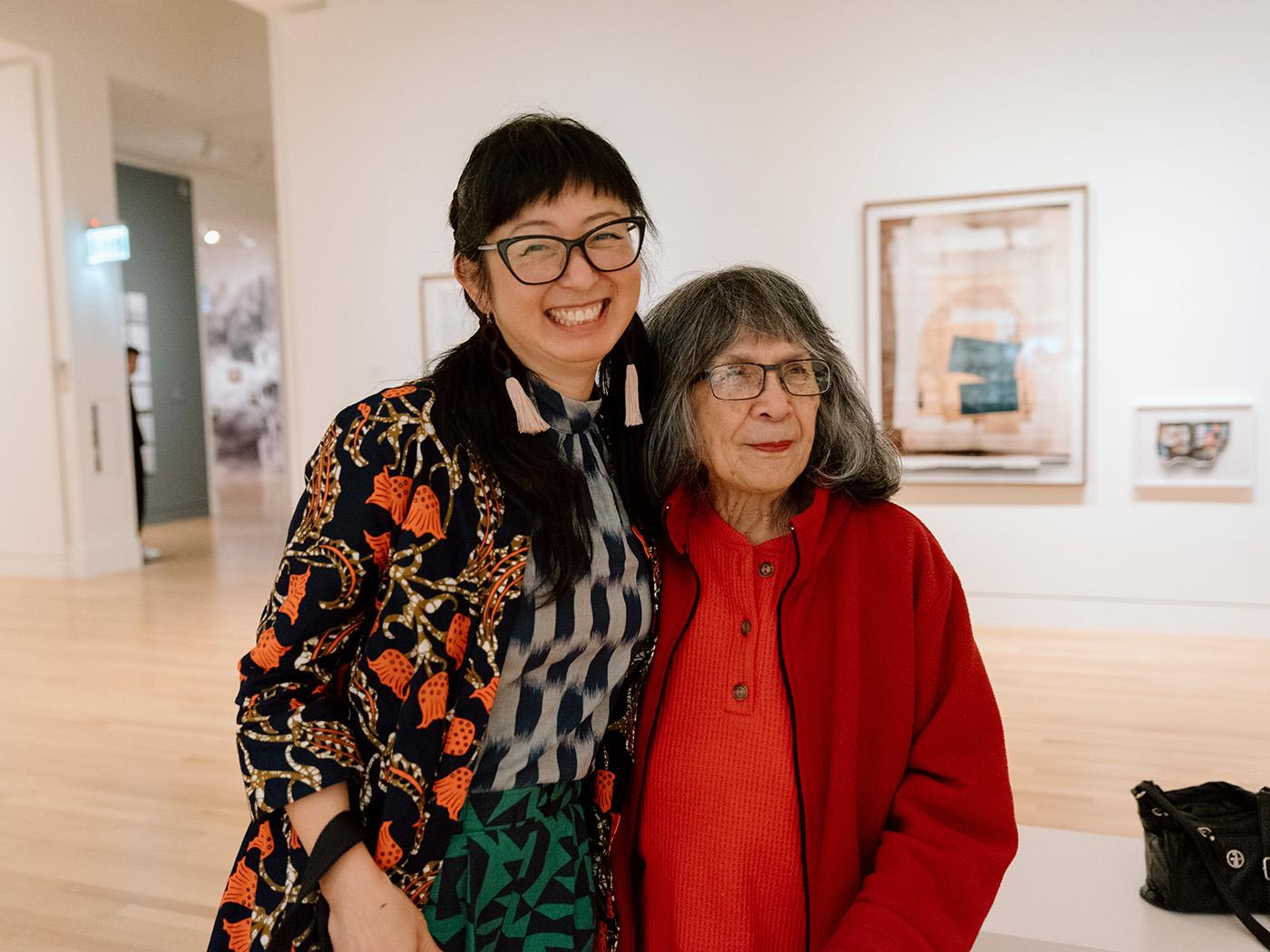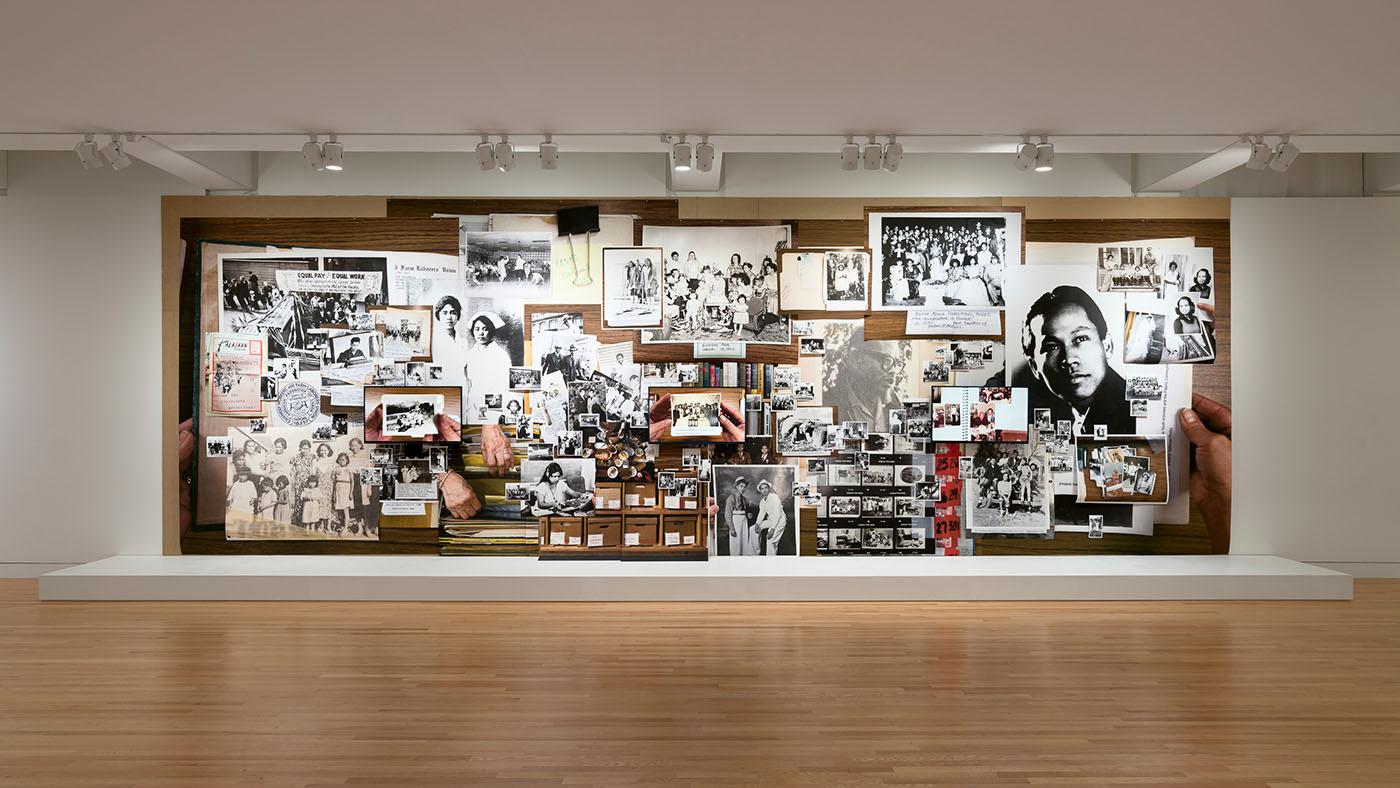Artist Stephanie Syjuco examines methods of storytelling and mythmaking of the American experience by mining the archives and collections of major institutions across the US. In December 2023 and February 2024, she visited the Filipino American National Historical Society (FANHS), located in Seattle’s Central District to conduct research for a piece commissioned by the Frye in conjunction with her exhibition After/Images (on view June 1–September 8, 2024). The resulting installation, Tender, Sifter, Keeper, Center offers a new direction for this practice: rather than approaching the archive with a critical lens, Syjuco lovingly showcases the material housed at FANHS, highlighting the important role archiving can play in community-driven storytelling.
To celebrate this collaboration, the Frye was honored to have the chance to speak with FANHS co-founder Dorothy Cordova, a Filipino American activist who herself grew up in the Central District. She shared with us the history and significance of this important community culture keeper. The following transcription has been edited for clarity and brevity.

Frye: Can you tell us about how FANHS came to be?
It started out as a continuation of a project that started in 1979. We got a grant from the National Endowment for the Humanities to gather the history of Filipinos and Koreans in the United States because at that time, they were the two largest groups from Asia coming in.
The Philippines is second only to Mexico in total immigration every year, starting in the ‘70s. And yet, if you went to libraries at that time, there was next to nothing about [Filipino immigrants]. And a lot of the information was misinformation.
So, there is a lot about Filipino American history that I never learned in school, even though we were the only Asian country that was actually part of the United States after the Spanish–American War. American history wasn't taught fully. They were teaching what they wanted to teach . . . it's important for me to make sure that our history was shared.
I wrote the grant, we got it, and it was for two years. We started finding out a lot of stuff. For example, I heard about a woman who was doing research on settlements [of Filipinos] in the late 1700s.
Of course, they weren't known as Filipinos, because the term Filipinos didn't come to us until around the time of the Spanish–American War. Only Spaniards born in the Philippines were called Filipinos. They referred to us as Indios.
They were Visayans, Ilocano, Tagalog, you know. It was wherever they lived and the dialects that they spoke. The term Filipino wasn't universally known to all of us until the late 1800s. And that's not in the history books . . . . They're starting to say it now, but it wasn't there.
So, it was important for us to start talking to old-timers. Why did they come to the United States? What were their dreams? Were they fulfilled? It was important because by the late seventies we'd gone through so many wars here in the United States which meant that the Filipinos here had gone through war with the United States: once against the United States, and then with the United States in World War II, the Korean War, and the Vietnam War.
Right after the Spanish–American War, there was the Filipino American War, which was not in Filipino American books [because] it was referred to as an insurrection against the United States. It took many years for the US to acknowledge these kinds of things. This is why [FANHS was] created . . . . The American story.
For many Filipinos now, we've been here a long time. My family's been here over a hundred years. The people before my parents came as American nationals. A lot of them were young, coming alone, without their whole family. And after 1965, whole families were coming. So all of a sudden, you had two generations of Filipinos coming, now both of them are first generation. And there were changes [in] the way we looked at things.
Did you notice a change in your communities in Seattle at this time?
Yeah, a lot of change. Part of it was a gradual thing. My parents coming as American nationals knew that their American-born children were American citizens.
They knew that. And so that was instilled in us. You are American. But we also knew we were Filipino, because growing up, I never felt that I was accepted as an American. [People would ask] what are you, and I say, “I'm Filipino, but I'm an American,” [and they’d say] “no you're not.” Because I didn't look their way of American.
But one of the things we did, especially in the city, our parents didn't instill in us the need to speak their dialect. When my parents came over, people were speaking the dialects from different regions. And one of the most interesting things was, in later immigrations, some of the new immigrants [would] speak to me in Tagalog.
And I couldn't understand Tagalog because my parents came from the north, they spoke Ilocano, and I said, “I'm sorry, I don't speak Tagalog.” And they said, “Well, you're not Filipino.” On one hand, I was told by white people I wasn't American, because I didn't look like them. And then on the other hand, I was told by Filipinos I was not Filipino, because I didn't speak what they spoke.
And so, that was a difference. It was, it was really different. My generation started really calling ourselves Filipino American, because that's what we were.
So where do we belong and who’s going to accept us? . . . I'm 92, and the community I grew up in, we were very close-knit, because we needed each other.
And that’s in part why it felt important to collect these stories?
I think the community, maybe by the time I was born, it was only around 5,000. By the time I started having my kids, [the population] was around 10,000 and then we really grew after that in Seattle.
But we were spread all over; a lot in small towns near farms. I started doing oral histories in the early seventies when I was doing Asian American-focused research on the immigrants coming over after 1965.
When the state first asked me to help with an oral history project, I had to turn them down because I was doing some other work, but the whole concept intrigued me when they told me what it was to gather stories. You interview people and they tell you stories. I thought that would be interesting, so I said [yes], as long as we could keep copies of everything, and they said no.
I told them, “I'm too busy.” . . . Then they came back again . . . . When they first [asked], they only wanted [to hear from] men who worked in the fields and went to Alaska [as migrant workers]. And I said, “See, another misconception . . . . There's more than that.” I mean, a lot of [Filipinos] who came early came to go to school, and they said, no, they never heard about it. And I said, but you were never taught. They finally said yes . . . and . . . also let us keep copies of whatever we did.
After that we started a collection, and that's what made me eventually write the grant to NEH. As the interviews were coming in from the state, I realized I didn't know anything. I thought I knew the people, and I knew them one way, but I didn't really know them. ‘Cause we started asking them about themselves.
I always thought there would be an end to this because I was used to doing projects. We were going to do this and finish, then we'd go on to the next project. Well, that was 1982 and there’s no end.
No end in sight!
Yeah, well there will be for me, I'll be gone. And probably very soon. But the work will keep going. There’s a lot I have to do still, so that the work won’t be lost.
What are your hopes for the future for FANHS? Do you hope we continue to collect stories and ask questions?
Well, I hope it remains open . . . . It's going to change. I know after I leave, there will be many changes. Because it was based on a need before. Before, we had to fight for a place in the sun, and now we have a place. So there's not that sense of urgency.
The needs change?
Yeah, and that's good. As long as they don't forget. Because that would be bad . . . . And the interesting thing is I’ve learned about so many friends. Before I was pretty Seattle-based. Now we have friends all over the country.

Visit the FANHS website to learn more.